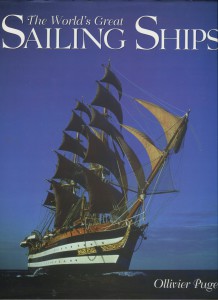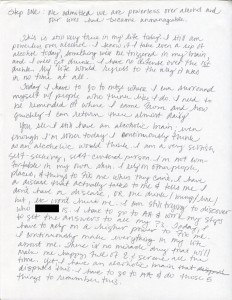Mr Oddbooks and I had a moment at a recent book sale wherein we both agreed we needed to buy a specific book because of a letter he had found inside of it. It was a coffee table book about sailing vessels (Mr Oddbooks is ex-Navy and longs for the coast like I long for the desert and here we both are in Austin) and was not particularly unique – he already had many books similar to this one. But the letter inside pulled us to buy it. The letter seemed as important as the book, if not more important, and as long as this book remains in our collection, that letter will remain inside the book, just as we found it.
I realized how often we both do this – purchase a book because something left in the book calls to us. I’ve come to think of this tendency as “biblio-sentimentality.” I have no idea how many books we have currently that we acquired due to our combined biblio-sentimentality, but I think I am going to record some of them here. I have to think others are like this, buying books because they feel an emotional connection to them due to marks and items left in the book. Perhaps others will enjoy seeing these books. Perhaps this is just more of my extremely indulgent blogging style. If so, no harm, but I can say that I would love to see any books you fine readers may have that you purchased due to biblio-sentimentality. Feel free to include pictures in comments!
I divide biblio-sentimentality into three categories: inscriptions, marginalia, and ephemera. Inscriptions, of course, are messages to a gift recipient or from the author, written generally on a title page, but could be included somewhere else in the book. Marginalia refers to notes about the text written in the blank margins of books, but it can also include highlighting or underscoring text. Ephemera refers to items found in the book that were not meant to be permanently left in the book, like letters, cards, bookmarks and similar.
In this entry I’m going to share some of our examples of biblio-sentimental ephemera, since this discussion was inspired by the sailing vessel book with the letter in it, and it seems fitting that I should begin with that book.
 Mr Oddbooks found this at a huge Half-Price Books warehouse sale. He really does have dozens of similar books but when the letter fell out of this book, he immediately read it and then put the book in our cart.
Mr Oddbooks found this at a huge Half-Price Books warehouse sale. He really does have dozens of similar books but when the letter fell out of this book, he immediately read it and then put the book in our cart.
 A woman fighting for sobriety left this letter to herself in a coffee table book about sailing ships. Though it is unlikely anyone would be able to identify her through this letter, I redacted her name anyway. This was a rescue ephemera – this letter seems very important to me, a woman with my own addiction demons. It was unusual that this woman placed this letter in such a book – was she using the book as a make-shift lap desk? Did she think this large book was the best place to keep such a letter since huge books about sailing vessels aren’t usually the types of books most read in the average home?
A woman fighting for sobriety left this letter to herself in a coffee table book about sailing ships. Though it is unlikely anyone would be able to identify her through this letter, I redacted her name anyway. This was a rescue ephemera – this letter seems very important to me, a woman with my own addiction demons. It was unusual that this woman placed this letter in such a book – was she using the book as a make-shift lap desk? Did she think this large book was the best place to keep such a letter since huge books about sailing vessels aren’t usually the types of books most read in the average home?
It worries me that she forgot about the letter in this book, or that there is a worse reason that this letter was left behind in a book, like she lost her possessions in an eviction. Or maybe she worked the steps and is clean and has no need to remember this letter. Regardless, it seemed callous to both of us to leave this book with this letter behind. It needed to be saved and kept. It seems very important to me even if I don’t know exactly why, outside of the shared experience of addiction.